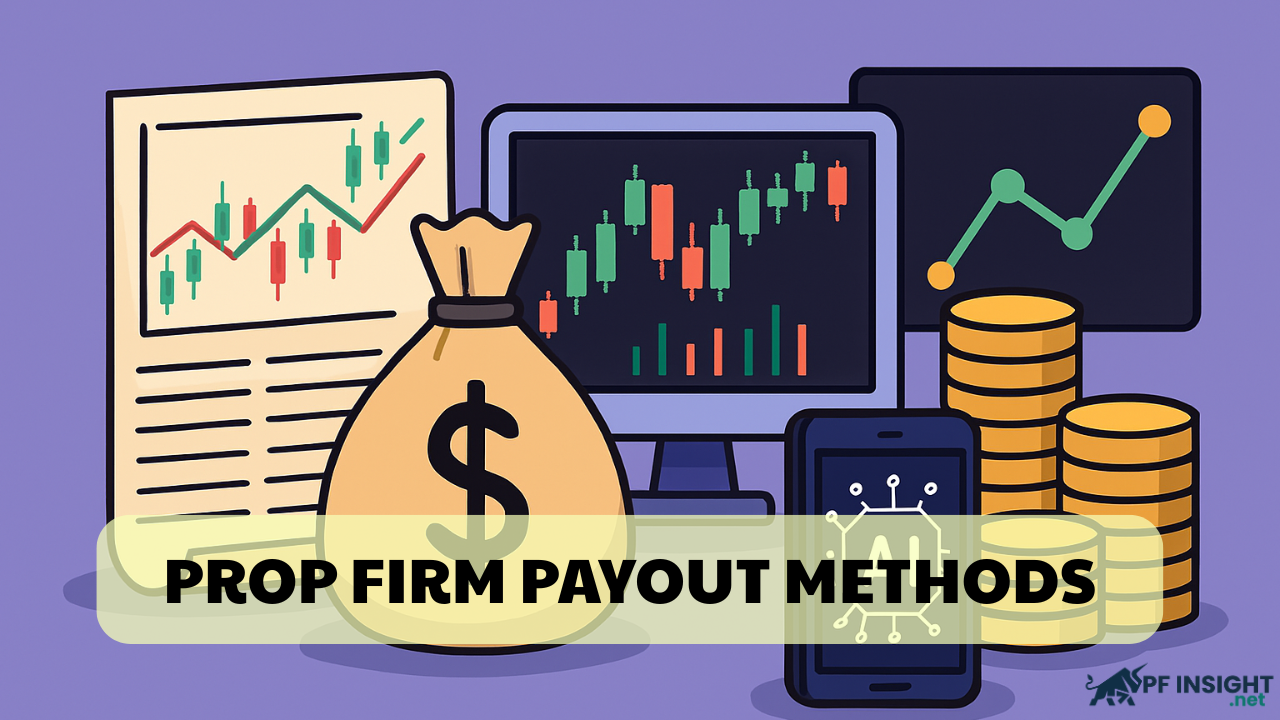Prop Firms are becoming increasingly popular among traders, offering them the chance to trade using company capital while earning a share of the profits they generate. However, one of the most important aspects that traders often overlook is how they will get paid. To make the most of your funded account, you need a solid understanding of Prop Firm payout methods.
In today’s article from Pfinsight.net, we’ll break down the different Prop Firm payout methods, explain how they work, and give advice on how to choose the one that best suits your trading style. Let’s dive in!
What are Prop Firm payout methods?

When you join a Prop Firm, you trade using the company’s capital. In return, you typically share a percentage of the profits with the firm. A Prop Firm’s payout method explains how and when you’ll receive your share of the profits.
Some firms provide immediate payouts, while others pay weekly or monthly. Certain firms offer a fixed profit split, while others increase your payout percentage as you demonstrate consistency. There are also significant differences in how funds are transferred, including bank wires, cryptocurrency transfers, and payment systems such as Payoneer and Wise.
To manage your trading career effectively, you must understand how each Prop Firm’s payout strategy works.
Why payout methods matter?
For every funded trader, selecting the right payout mechanism is crucial because it directly affects how you manage and grow your revenue. Reliable and timely payouts help create a stable cash flow, enabling you to reinvest profits into trading or cover personal expenses seamlessly.
Additionally, by recognizing performance milestones, some payout structures can further optimize your earnings and allow you to retain a larger share of profits as your performance improves.
Immediate or on-demand withdrawals give you greater freedom and flexibility, allowing access to your funds whenever you need them. However, it’s important to consider costs and fees, as some payout methods – particularly international bank transfers – can significantly reduce your actual take-home income.
Ultimately, the right payout structure can help you build a more successful funded account, maintain motivation, and encourage long-term growth alongside improving profitability.
Main types of Prop Firm payout methods

Payout terms are one of the top factors traders consider when choosing the most effective Prop Firm. Understanding how each model works can help you plan your trading revenue better, as each approach has its own advantages and drawbacks. Below are the most common payout methods you’ll encounter in today’s proprietary trading market:
Profit split (percentage-based payouts)
Among all Prop Firm payout options, the profit split is the most common and straightforward. Under this model, the firm keeps a portion of the profits earned, while the trader retains the rest. Common profit-sharing ratios favorable to traders include 70/30, 80/20, or even 90/10.
This structure is clear, easy to understand, and directly tied to performance. However, sometimes you can only access higher profit splits after completing specific evaluation phases or growing your funded account.
Fixed payouts
The fixed payout model is another common payout method. Instead of taking a share of income, traders receive a set amount each month or payout cycle, depending on their performance tier.
The main advantage of fixed payouts is predictable income, which makes budgeting easier. The downside is that because the payout remains capped, you might miss out on additional profits if you exceed expectations.
Instant or on-demand payouts
Instant or on-demand payouts are becoming increasingly popular in the industry. Rather than waiting for a scheduled date, traders can cash out under this payout strategy as soon as they reach the minimum threshold.
This approach gives you more control over your cash flow and instant access to your earnings. However, some firms limit the number of times you can request instant withdrawals or charge a small fee, making it essential to read the rules carefully.
Scheduled payouts
One of the most traditional and well-known payout strategies is scheduled payouts. Under this model, traders are paid their share of profits weekly, bi-weekly, or monthly.
For those who prefer simple financial planning and consistent payment schedules, this is an excellent option. The downside is that it may not be ideal if you need quick access to funds between payout periods.
Tiered payout structure
Tiered payout programs are designed to encourage steady and sustainable growth. With this strategy, traders start with a lower profit split – such as 70/30 – and as they reach certain milestones or grow their funded accounts, they move up to higher splits, such as 80/20 or 90/10.
For diligent traders looking to gradually increase their earnings, this method can be very helpful. However, achieving the highest payout levels requires patience and consistent performance.
How to choose the best Prop Firm payout methods for you

Choosing the right Prop Firm is just as important as selecting the appropriate payout method. Your cash flow, growth potential, and even trading motivation can all be influenced by how you’re paid. You can identify the payout structure that best suits your needs by carefully weighing your options and considering your personal requirements.
First, assess your cash flow needs. If you rely on trading revenue for daily expenses, you may benefit from weekly or instant payouts, which give you steady access to profits. On the other hand, monthly payouts may be more reasonable if you can wait – and in some cases, they even come with better terms or larger profit shares.
Next, review the profit split details. Pay attention to more than just the headline percentage. Instead, find out whether the split changes over time, what achievements are required to reach higher percentages, and whether any hidden restrictions or costs might reduce your actual earnings.
Comparing fees associated with each payout method is also crucial. In some cases – but not always – cryptocurrency transactions may be less expensive than bank transfers. While some Prop Firms pass transaction costs directly to traders, others cover these costs for you. Knowing these details in advance helps you avoid unpleasant surprises later.
Checking the minimum withdrawal criteria is another key step. Many firms require a minimum profit threshold before you can request payouts. By understanding these guidelines beforehand, you can better plan your trading goals and avoid delays in receiving your funds.
Finally, think about your scaling strategy. If your goal is to move up to higher funded accounts, the ideal choice would be a firm with a tiered payout structure. By increasing your profit share as you grow, these models encourage consistent performance and give you a larger slice of your earnings over time.
By considering these factors carefully, you can select the Prop Firm payout method that best fits your trading preferences, long-term career goals, and financial needs.
Conclusion
Overall, beyond focusing on your trading strategy and risk management, understanding Prop Firm payout methods is equally important. Each payout type – whether profit split, fixed payouts, instant payouts, or tiered payout systems – comes with its own advantages and limitations.
When you carefully evaluate your cash flow needs, profit split percentages, transaction fees, minimum withdrawal conditions, and account scaling plans, you’ll find it much easier to choose the payout method that’s right for you.
We hope this article has given you a comprehensive overview. Wishing all traders success!







